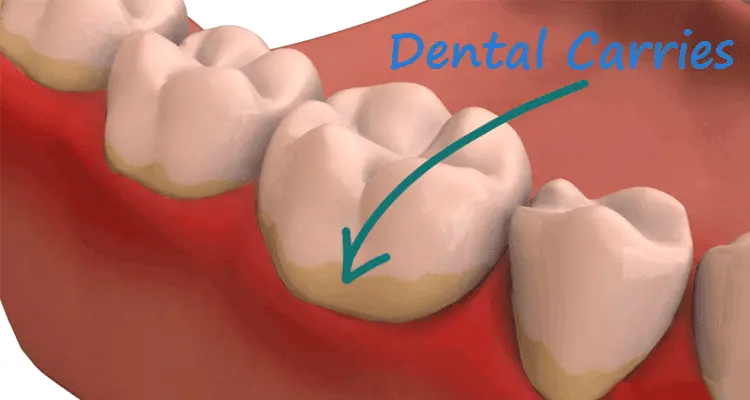Dental caries, more commonly known as cavities, are a widespread oral health concern affecting people of all ages. These holes in your teeth can lead to pain, sensitivity, and even tooth loss if left untreated.
Don’t waste time, let’s explore the causes of tooth decay, delve into effective preventive strategies, and shed light on the importance of early detection and treatment.
What are Dental Caries?

Dental caries, or cavities, are holes in your teeth caused by bacteria. These bacteria feed on sugar and produce acid, which eats away at your tooth enamel.
Brushing poorly, eating sugary foods, having dry mouth, and not getting enough fluoride can all contribute to cavities. If left untreated, cavities can cause pain and infection.
8 Common Causes of Dental Caries or Tooth Decay
To effectively prevent cavities, we must first understand the factors that contribute to their development:
1. Bacteria and Plaque Buildup
The primary culprits are Streptococcus mutans and Lactobacillus bacteria. These thrive in the sticky film called plaque that accumulates on teeth if not removed through proper brushing and flossing. As they feed on sugars in your diet, they produce acids that erode tooth enamel, the hard outer layer of your teeth.
2. Dietary Choices
Frequent consumption of sugary foods and drinks fuels the acid-producing bacteria. Sticky candies, chips, and sugary beverages linger on teeth for extended periods, allowing bacteria a continuous feast. While fruits are generally healthy, be mindful of dried fruits that can cling to teeth.
3. Inadequate Oral Hygiene
Brushing twice daily for two minutes with fluoride toothpaste and flossing once a day are crucial for removing plaque and food debris. Insufficient brushing and flossing allows bacteria to flourish and perpetuate the cycle of acid production, leading to enamel erosion and cavity formation.
4. Lack of Fluoride Exposure
Fluoride strengthens tooth enamel and enhances remineralization, the natural process of repairing early enamel damage caused by acid. Inadequate exposure to fluoride from fluoridated water, toothpaste, or professional treatments can leave teeth vulnerable to decay.
5. Dry Mouth Conditions
Saliva plays a vital role in neutralizing acids, remineralizing tooth surfaces, and washing away food particles and bacteria. Dry mouth, caused by factors like Sjögren’s syndrome, medication side effects, or radiation therapy, reduces these protective mechanisms, creating a breeding ground for bacteria and acid production.
6. Genetics and Medical Conditions
Genetic disorders affecting enamel formation and certain medical conditions like GERD (gastroesophageal reflux disease) or eating disorders can increase the risk of tooth decay by exposing teeth to acids more frequently.
7. Environmental Factors
Prenatal and early childhood exposure to heavy metals like lead and cadmium can disrupt enamel development, increasing cavity risk later in life. Additionally, secondhand smoke exposure in children has been linked to a higher risk of tooth decay.
8. Socioeconomic Status
Individuals from lower socioeconomic backgrounds may have limited access to dental care, preventive services, and education on oral hygiene, leading to a higher incidence of cavities. Additionally, poverty can contribute to poor nutrition and increased consumption of sugary foods, further exacerbating the problem.
Stopping Cavities Before They Start: Effective Dental Caries Prevention
Dental caries, commonly known as cavities, are a preventable oral health concern. While brushing and flossing are important, a multi-pronged approach is most effective in keeping your smile cavity-free.

Brushing and Flossing: The Essentials
Regular brushing and flossing form the foundation of good oral hygiene. Brushing twice a day for two minutes with a fluoride toothpaste removes plaque, a sticky film harboring bacteria that produce cavity-causing acid.
Flossing reaches between teeth where brushing can’t, removing plaque and food particles that could lead to decay.
Diet: Limiting Sugar and Making Smart Choices
Sugary foods and drinks are major culprits in cavity formation. Bacteria feed on sugar, producing acid that erodes tooth enamel. Reduce sugary snacks and drinks, and opt for water or unsweetened beverages. Sticky candies and chips linger on teeth, increasing the risk of cavities. Fruits are a healthy choice, but be mindful that dried fruits can stick to teeth.
Fluoride: Your Ally Against Cavities
Fluoride strengthens tooth enamel and helps prevent cavities. Use fluoridated toothpaste and consider a fluoride mouthwash. Community water fluoridation is a proven public health measure that significantly reduces cavities.
Dental Sealants: Extra Protection for Children
Dental sealants are thin plastic coatings applied to the chewing surfaces of back teeth. They create a barrier, preventing food and bacteria from getting trapped in grooves and pits where cavities often form. Sealants are a great way to protect children’s teeth.
Regular Dental Checkups: Early Detection and Prevention
Schedule regular dental checkups and cleanings. typically every six months. These visits allow your dentist to identify and address cavities early, preventing them from progressing into more serious issues. Our dentist can also recommend additional preventive measures like fluoride treatments tailored to your individual needs.
Additional Tips
Embrace Xylitol
Consider using sugar-free gum or candies containing xylitol. Xylitol is a natural sugar alcohol that can reduce cavity formation by inhibiting the growth of certain bacteria.
Manage Dry Mouth
If you experience dry mouth, consult your dentist for solutions to increase saliva production. Artificial saliva products or sugar-free lozenges can provide temporary relief.
Be Mindful of Medications
Certain medications can cause dry mouth as a side effect. Discuss alternative options with your doctor if possible, and prioritize excellent oral hygiene practices to compensate for reduced saliva flow.

Signs and Symptoms of Tooth Decay (Dental Caries)
Tooth decay, or dental caries, is a progressive condition that can initially be asymptomatic. However, as the disease advances, various signs and symptoms may become evident. Here are some common indicators of dental caries:
Early Signs
Chalky white spots on the tooth surface, known as white spot lesions, indicate an area of enamel demineralization – the earliest visible sign of tooth decay.
These white spots may appear dull or discolored initially, but they are reversible at this stage with proper intervention.
Progressing Symptoms
As the decay process continues, the affected area may turn brown or black, indicating the formation of a cavity or hole in the tooth structure.
Once a cavity forms, the lost tooth structure cannot be regenerated naturally.
Stained or discolored areas on the tooth surface may indicate arrested or inactive caries, where the demineralization process has halted.
Advanced Symptoms
Visible cavities or holes in the teeth become more noticeable as the enamel and dentin (inner tooth layer) are destroyed.
The affected tooth areas may appear soft or sticky to the touch.
Sensitivity or pain may arise when consuming hot, cold, or sweet foods and beverages, as the exposed dentinal tubules (tiny canals) allow sensations to reach the nerve.
Extensive tooth decay can weaken the tooth, leading to sudden fractures or crumbling under normal chewing forces.
Severe Complications
Constant, severe toothache or throbbing pain may occur if the decay reaches the pulp (innermost layer containing nerves and blood vessels).
Abscess formation, swelling, or infection in the surrounding tissues can develop if the decay remains untreated.
Note:
Bad breath or an unpleasant taste in the mouth may result from deep cavities or infections.
In severe cases, complications like cavernous sinus thrombosis or Ludwig’s angina (potentially life-threatening) can arise from untreated dental infections.
Early Detection and Intervention: The Key to a Healthy Smile
Regular dental checkups are crucial for early detection of cavities. Even small cavities can be addressed through minimally invasive procedures, preserving more tooth structure and minimizing discomfort. Here’s what to expect:
Visual Examination
Dentists will visually examine your teeth for signs of decay, discoloration, or weakness.
X-rays (if necessary)
Dental X-rays may be used to reveal cavities between teeth or beneath the surface invisible to the naked eye.
Early Intervention
Depending on the severity, treatment options may include:
Remineralization
For non-cavity lesions, your dentist might recommend topical fluoride treatments or suggest dietary and oral hygiene modifications to promote natural remineralization of early enamel damage.
Non-surgical Treatment
For small cavities, dentists can often remove decay using air abrasion or other techniques without drilling.

Treatment Options for Cavities: Restoring Your Smile
If a cavity is diagnosed, fret not! Several effective treatment options can restore your tooth and prevent further damage:
Fillings
For mild to moderate cavities, fillings are the most common treatment. Dentists remove decayed material and fill the cavity with a biocompatible material, restoring the tooth’s shape, function, and aesthetics. Common filling materials include:
- Composite Resin: Tooth-colored and aesthetically pleasing, but may not be as durable as other options.
- Dental Amalgam: Strong and durable, but the metallic appearance might not be ideal for everyone.
Crowns
In cases of extensive decay or damaged fillings, a crown may be necessary. A crown is a cap that covers the entire tooth, restoring its strength, function, and appearance. Crowns are typically made of porcelain or ceramic and can be color-matched to blend seamlessly with surrounding teeth.
Root Canals and Extractions
In severe cases where the pulp (inner tooth) becomes infected, a root canal is needed. This procedure removes the infected pulp and preserves the tooth structure. However, if the tooth is too damaged or poses a future risk, extraction may be recommended.
Maintaining a Healthy Smile: A Lifelong Commitment
Preventing tooth decay is an ongoing process that requires commitment and consistency. By incorporating the strategies outlined above into your daily routine and maintaining regular dental checkups, you can significantly reduce your risk of cavities and ensure a healthy, radiant smile for life. Remember, prevention is always better than cure!
Additional Tips By Dr. Md. Mostafizur Rahman Khandaker
Consider using a tongue scraper
Brushing your tongue helps remove bacteria and debris that can contribute to bad breath and potentially increase the risk of cavities.
Don’t use your teeth as tools
Avoid using your teeth to open bottles, crack nuts, or chew on hard objects. This can damage your teeth and increase the risk of chipping or cracking.
Replace your toothbrush regularly
Change your toothbrush every three to four months, or sooner if the bristles become frayed.
Stay hydrated
Drinking plenty of water helps flush away food particles and bacteria from your mouth and promotes saliva production.
Be smoke-free
Smoking and tobacco use increase your risk of gum disease and oral cancer, which can indirectly affect tooth health.
FAQ About Dental Caries (Cavities)
What organism causes dental caries?
Microscopic troublemakers called Streptococcus mutans and Lactobacillus bacteria are the culprits. They live in plaque, feasting on sugars and producing cavity-causing acid.
How to remove dental caries?
The method depends on severity. Early cavities might remineralize naturally with better hygiene and fluoride. Mild to moderate cavities require fillings. Extensive decay or damaged fillings may need crowns. In severe cases, root canals or extractions might be necessary.
What causes cavities in teeth?
Several factors contribute:
- Bacteria & Plaque: When sugary foods aren’t removed, bacteria in plaque produce acid that erodes enamel.
- Sugary Diet: Frequent sugary treats fuel these acid-producing bacteria, increasing cavity risk.
- Poor Oral Hygiene: Brushing twice daily and flossing once a day are crucial to remove plaque and bacteria that can damage teeth.
Does lack of fluoride cause cavities?
Yes! Fluoride strengthens enamel and aids in remineralization, the natural repair process for early enamel damage. Without enough fluoride, teeth are more vulnerable to decay.
What other factors can cause cavities?
Dry mouth conditions, genetics, certain medical conditions, environmental factors, and even socioeconomic status can all play a role in cavity development.
Takeaway
Maintaining a healthy smile is achievable through a combination of preventive efforts, early detection, and proper treatment.
By understanding the causes of cavities and implementing the strategies outlined in this guide, you can empower yourself to prevent tooth decay and enjoy the benefits of a healthy smile for years to come. Schedule your next dental checkup today and take charge of your oral health!


